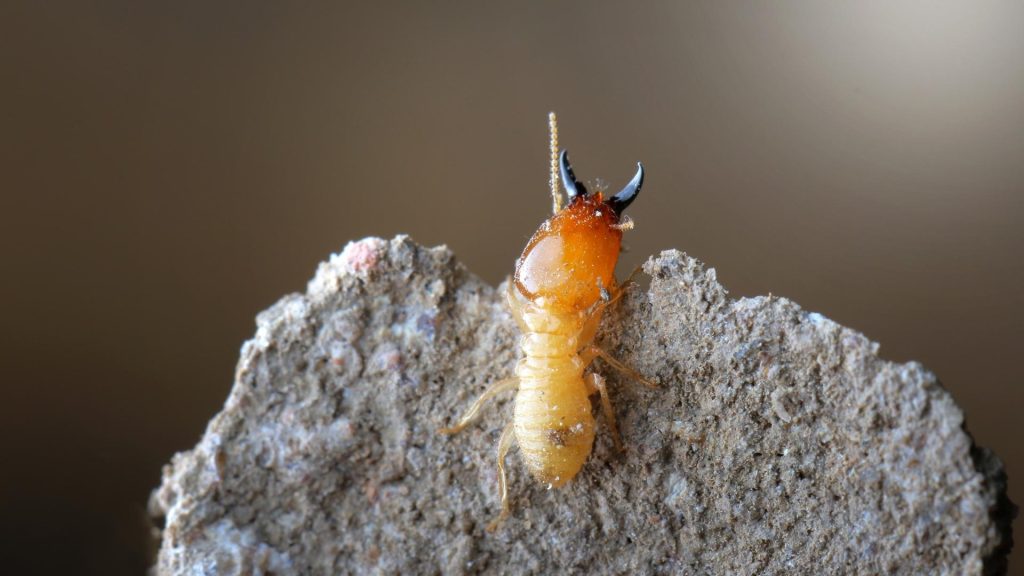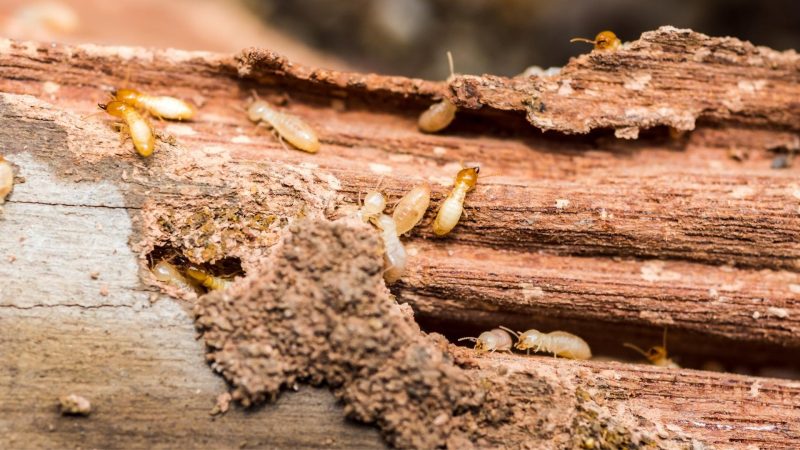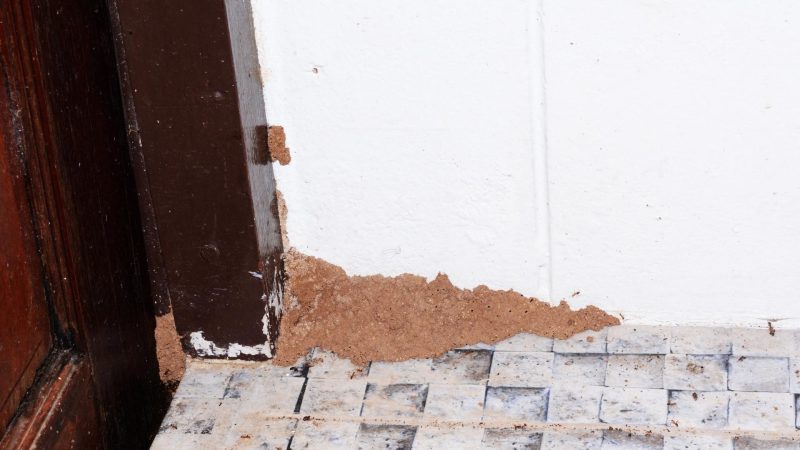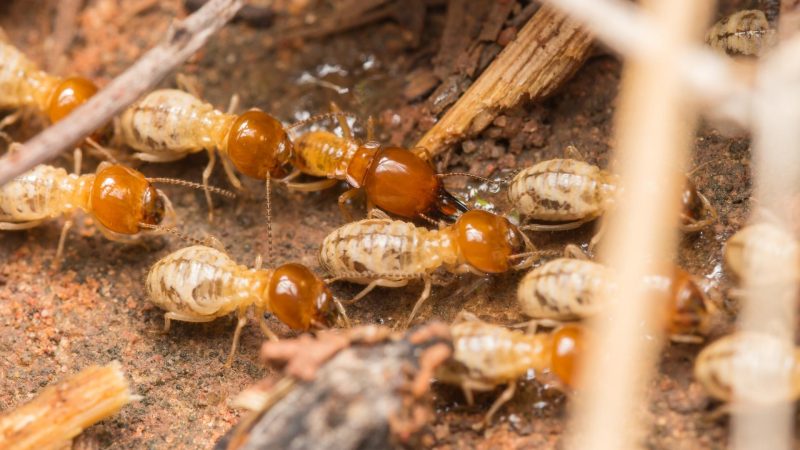Termites are known for being among the most destructive pests in the world. These wood-destroyers damage houses slowly and silently, making lots of homeowners unaware until they discover that the infestation is already severe. This is mainly because they don’t know that there are active termites inside.
How to tell if termites are active in your house? There are several ways to tell if there are active termites inside your house. This includes the presence of termite swarmers, mud tubes, termite droppings and wings, and swarm castles. Your drywall paint may also have some bubbles and pinholes or is slowly peeling off.
According to estimates, controlling termites and preventing infestations in the United States costs more than $2 billion per year.
The figure does not yet include the cost for damage repair due to house termites. In this comprehensive guide, you will learn how to properly identify house termites and how to get rid of them.
Table of Contents
What Do House Termites Look Like?

There are over 2,600 species of termites around the world, and all of them somehow look the same. In general, all house termites have straight antennae, a broad abdomen, and a very narrow waist but sometimes none. Reproductive termites have 2 pairs of white or transparent wings that have equal lengths.
Also called alates or swarmers, reproductive termites have a black or yellow-brown body, compound eyes, and are about 1/4-3/8 inches long. They lose their wings once they find their mates.
Meanwhile, soldier and worker termites are lighter in color and are wingless. Soldiers have bigger mouthparts than workers.
The three most common types of termites in the United States are subterranean termites, damp wood termites, and drywood termites. All of them are somehow look-alikes and are usually mistaken for ants.
Termite queens are the largest among them all, and they have an enlarged stomach that is always full of eggs.
What Causes Termites to Invade Your House?

Termites eat cellulose, which is the main component of wood. This is why they are very attracted to the wooden parts of your house, such as walls, ceilings, floor, and furniture. As the name implies, damp wood termites are attracted to moist wood, while drywood termites are very attracted to dry and dead wood.
On the other hand, subterranean termites are very attracted to wood that is in direct contact with soil. Formosan subterranean termites are termite species that are very attracted to lights at night, which is why you can see their swarmers flying mostly at night. In general, termites invade houses in search of food.
How Do Termites Get Into Your House?
Termites can enter your house in various ways, depending on the species. Damp wood termites and drywood termites don’t need soil to enter your house. They can get inside through very small gaps on your windows, doors, and through your roof. Nonetheless, some swarmers may start a new colony somewhere else.
Meanwhile, subterranean termites dig nest tunnels in the soil and build mud tubes as their path to enter your house through the foundation.
They may also get inside through cracks, slabs, electrical lines, and leaky pipes. But whatever termite species enter your house, they are likely the termite workers, not soldiers.
Do Termites Spread From House to House?
Termites don’t spread from house to house themselves. Once they are building or have built a colony inside a house, they will not move to another house even if that house is very near. Termites can only move from one house to another if someone will bring infested wood from their house to another house.
What Do Termites Do to Your House?
All types of termites will eat your house very slowly. Drywood termites will build nests within the wood, while subterranean termites will infest wood and will bring them little by little to their underground nests. Damp wood termites may also build nests inside but only in houses with high moisture levels and will eat moist wood.
How Fast Can Termites Eat Your House?
So far, no scientific studies are showing how fast termites can eat an entire house. Note also that the number of termites in a colony depends on the species.
A drywood termite colony may only have about a few hundreds to thousands of termites, while a subterranean termite colony can have hundreds of thousands.
But to give you an idea, an experiment was conducted to check how long a colony of 2,000 Formosan subterranean termites can eat an entire model house measuring 30 x 20 centimeters and 2 millimeters thick. Amazingly, it took them only 3 weeks! It is estimated that a mature colony eats 5 kilos of wood a month!
How Do You Know if Your House Has Termites?

It takes more than three years for termites to establish a colony before they can produce swarmers. Therefore, seeing one or two swarmers inside your house does not necessarily mean there is already a termite infestation.
These winged termites may have only accidentally entered your house and will soon be gone.
As mentioned above, drywood termites and subterranean termites infest wooden structures. This means that you cannot see them as they slowly damage your house. Note also that most swarmers die before they can start a new colony. With that, here are some notable signs that your house has termites:
1. Lots of Swarmers
Once swarmers are dramatically increasing inside your house, it means that the termite colony inside has already a huge population. Some of these winged termites may be flying everywhere, while others may be lying dead on the floor. But again, termites also look like ants, so better take a closer look at them.
2. Mud Tubes
Mud tubes are about 1/4-1 inch in diameter or as thick as an ordinary pencil and are made by subterranean termite workers. These so-called shelter tubes are usually made of dirt, wood particles, and saliva. The workers use them to go back and forth to their underground nests to bring food to the queen and larvae.
3. Termite Feces
Drywood termites expel their feces or droppings through small “kick-out” holes or openings of horizontal surfaces. These termite feces (fecal pellets) are oval capsules that have six concave sides. They are about 1-2 mm long and vary in color, depending on the species, regardless of the color of wood they eat.
4. Termite Wings
As mentioned earlier, termite swarmers will naturally drop off their wings on the floor once they find the perfect match so they can start a new colony. And since each swarmer has four wings, the sight of tons of wings on the floor is a clear indication that there are already termites inside the house hiding somewhere.
5. Pinholes on Drywall
If your drywall or ceiling has some pinholes, they are very likely to be exit holes of termites. In some cases, this is also where termites expel their feces. If these pinholes are covered with crusty lumps of sand, they were done by subterranean termite workers. Drywood termites also bore tiny holes but don’t add soil to them.
6. Swarm Castles
Swarm castles are dried mud on ceilings and walls and are usually made by subterranean termites. These castles are mud tunnels that become bigger as workers continue to build them. Their size depends on how long termites are making them. Some of them have termites inside, while some are empty.
7. Wall Paint Peels off or Has Bubbles
If your drywall paint is peeling off or has some bubbles, chances are there are lots of termites inside. These two scenarios usually happen when the termites inside are already overcrowded. If you check your wall and find no termites, there could be excess moisture, and subterranean termites may soon hide inside.
8. Painted Wall Is Sinking
Termites don’t eat paint but feed on the outer covering of a painted wall and wood paneling. So, if your painted wall is slowly sinking but has no excess moisture in it, termites are very likely to be eating within the wall. If the sunken area forms a line, it could mean that termites have already created a path.
9. Tightened Windows and Doors
If your wooden windows and doors are now difficult to open or close, it could be due to old age, accumulated dirt, or excess moisture. But if they are not yet that old and are still dry, chances are there are already hundreds of termites eating the wooden frame or within the walls that are in contact with the door or windows.
10. Hollow and Headbanging Sounds
Tap the wall lightly and listen closely. If you hear some hollow sounds inside your drywall or ceiling, drywood termites are very likely to have already eaten a huge part. Headbanging sounds strongly suggest that termites are disturbed. Termites will bang their heads on the wall to warn the colony of potential danger.
11. Check the Foundation
To know if your house has subterranean termites, check its foundation. Using an ordinary screwdriver or any short sharp metal bar, probe the header joists, sill plates, baseboard, bases of wall studs, and ends of floor joists. If the wood offers only a little resistance against the probe, tons of termites could be inside them.
Can You Live In a House With Termites?

You can still live in a house with termites. These destructive pests don’t bite humans and don’t carry diseases. Therefore, living with them is not dangerous.
But if you continue living in a house with termites and you don’t do anything to get rid of them, your house may soon be no longer suitable for human habitat.
When Does a House Need to Be Tented for Termites?
Tenting a house means covering it entirely with tents and tarpaulins because it will be subjected to fumigation. Also called structural fumigation, this process involves trapping gas (sulfuryl fluoride) so that all drywood termites and their eggs that are hiding in cracks, crevices, and pores in the wood will be killed.
However, the process is different when dealing with subterranean termites and should only be done by licensed pest control services. Fumigation is considered the most effective way to treat termites. Nonetheless, it is necessary only in very severe termite infestations or when termites become uncontrollable.
How Much to Tent a House for Termites?
Depending on the severity of the infestation, the average cost for tenting an entire house is $1 to $4 per square foot, or between $1,280 and $3,000. A cheaper option is the heat treatment, which is odorless and does not require chemicals. The price is $1 to $2.50 per square foot, or between $800 and $2,800.
How to Kill Flying Termites in the House?
As mentioned earlier, most flying termites don’t live long and will die shortly after losing their wings. These swarmers also don’t eat wood and don’t damage any part of the house. But since their purpose is to find a mate so that they can start a new colony, here are some simple ways to kill flying termites inside your house:
- Get a broom and swat them to death.
- Use a vacuum cleaner to suck them.
- Use non-toxic and odorless termite spray such as TERRO Carpenter Ant & Termite Killer.
How to Keep Flying Termites Out of Your House?
Termite swarmers are nuisance pests and may be an indication that your house has termites or a termite colony is nearby. Nevertheless, killing them is not the ultimate solution against termites.
But if you want to keep swarmers out of your house and prevent them from coming back, here are some things you can do:
- Seal all cracks and crevices in window screens, doors, walls, and attic.
- Look for signs of excess moisture such as leaky pipes or roofs, and fix them.
- Check for damaged pet doors and vents, and repair them.
- Inspect the wood structures in your foundation and make sure they are dry.
How to Get Rid of Termites in House Naturally?
If you notice the early signs of termite activity in your house, you might want to take action immediately.
Although termites are very small, huge numbers can eat your wall faster than you think. If you don’t want to use pesticides that contain harmful ingredients, here are some natural ways to get rid of termites:
- If the infested wood or structure can be removed from your house, bring it outside and burn it.
- Place cardboard bait traps in infested areas. Cardboards have cellulose, which termites eat. Once the cardboard trap has termites, burn it and put another one. Note that this strategy only works in a colony with few termites.
- A 2020 study showed that treating termite-infested wood with wintergreen essential oil and heat treatment at 134-146°F (56.6-63.3°C) for 140 minutes had a 92% to 100% mortality rate after 7 days. Without the essential oil, the mortality rate is only 36% to 44%. Wintergreen essential oil also works better than orange oil.
- Treat infested areas with natural products such as HARRIS Diatomaceous Earth Food Grade. A 2018 study revealed that 6 hours of applying dry DE to wood infested by subterranean termite resulted in a 100% mortality rate. Read the label carefully before using it.
Note: Most DIY (Do-it-yourself) treatments are only effective in mild infestations. For severe cases, you should ask help from pest control professionals.
How to Prevent Termites in the House?
Getting rid of termites can be very challenging and costly. So, instead of waiting for them to eat your house slowly, you should perform some preventive measures as soon as possible.
Although most termite infestations are hard to predict, here are some recommendations that can help prevent termites from entering your house:
1. Avoid wood from having direct contact with soil.
Ideally, wooden structures such as window and door frames should be installed at least 6 inches above the ground.
Contrary to common belief, using pressure-treated wood is not a guarantee that subterranean termites will no longer eat it.
2. Your foundation should be free from moisture.
Make sure your gutter, downspouts, and splash blocks are always clean and dry. Face your water sprinkles away from them. Check your drainage if it is working properly, and repair leaky pipes and air conditioning units as soon as possible.
3. Keep firewood and plants away from your house.
Firewood, lumber, newspapers, cardboard boxes, and other potential food sources of termites should not be stored near your house. Also, avoid placing plants near your home and remove dead roots around and under the foundation.
4. Use mulch correctly.
Mulch helps improve soil fertility, suffocates weeds, and retains soil moisture. Yet, termites are more attracted to their moisture-retaining properties than wood, no matter what kind of mulch you use. This is why you should not apply excessively.
5. Install termite bait stations.
Once there are already subterranean termites outside your house, try installing termite bait stations such as BASF Advance Termite Bait Stations. However, you should only use applicable bait such as Trelona Compressed Termite Bait.
6. Create termite barriers.
Create a termite barrier around your house. To do this, treat the soil around and under your house with termiticides such as BioAdvanced Termite Killer Home Perimeter Treatment. In most cases, this method requires drilling of soil.
Summary
Termite control is a complex process, and there is no guarantee that termites will no longer return after treatment or fumigation. In most cases, applying termiticides should be done repeatedly. Therefore, it’s better if you hire a reputable pest control firm to regularly check hidden areas, such as walls and foundations.
List of Sources
Termites – Biology and Control